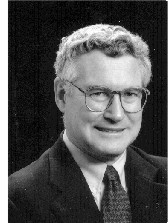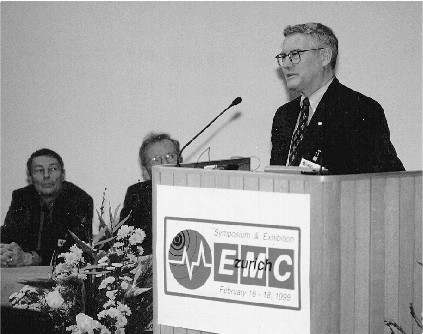

Dan Hoolihan
President, EMC Society
In this newsletter I would like to take this opportunity to write about EMC Society Membership for the purpose of generating some discussion on the topic in the local Chapters in our Society. For logical reasons, I have presented the discussion in three parts; Past, Present, and Future.
Historically, the EMC Society and the entire IEEE membership has been centered around the United States and the members within the United States. This is primarily a result of its origination as the American Institute of Electrical Engineers (AIEE) in 1884 coupled with its merger in 1963 with the Institute of Radio Engineers. The fact that the IEEE is headquartered in the United States in a city that has an American Indian name (Piscataway) adds to the perception on the part of many of our Society members in Regions 7-10 that the IEEE is a “United States” organization.
The EMC Society actually started as a Professional Group on Radio Frequency Interference (PGRFI) one of several Professional Groups in the Institute of Radio Engineers (IRE). This group was approved by the IRE on October 10, 1957. In 1964, as a result of the merger, with the AIEE, the EMC Group was reformulated as a Society of the IEEE.
The early records indicate an enrollment of 380 or so engineers in 1958 which grew to around 1500 engineers in 1964. There is no indication as to what percent of those RFI engineers were from outside the United States, at least, as reported in the IEEE Transactions on EMC dated August of 1983 (the 25th anniversary edition- Silver anniversary edition - of the EMC Society).

EMC Society President Dan Hoolihan is pictured addressing the
audience at EMC Zurich '99.
He provided a short introduction to the IEEE and EMC Society. Seated behind the podium are
Professor M. Ianoz, URSI Swiss National Committee, and Professor Peter Leuthold,
Zurich Symposium President (partially pictured).
The records on membership information from the IEEE indicate an EMC Society membership total around 4300 in December of 1992 and 5200 in December of 1998 (a 21% increase). In 1992, the Society Membership was 65% from within the United States, 18% from Region 8 (Europe), 11% from Region 10 (Pacific Rim), 5% from Region 7 (Canada), and 1% from Region 9 (South America). By 1998, only 57% of our Society’s members came from the United States while Region 8 had increased to 24%! Region 10 had increased to 13% and Region 9 had doubled to 2% while Region 7 had slipped a percentage point to 4%.
If the trend over the last 7 years continues, it is evident that in about 10 years (2010) the majority of the EMC Society’s membership will come from outside the United States!
What will be the implications of this geographical membership distribution for the EMC Society?
With a majority of the EMC Society members coming from outside the United States, the EMC Society of the IEEE will truly be a global/international/transnational organization. What changes in policy and procedure and administrative bylaws should our Society be considering to handle this change?
One change I think we should consider is having the Board membership reflect the regional distribution in a more equitable manner. One possible way of doing that is mandating that we have at least one Board member from each Region on the Board every year. We would then have eight board members elected at an At-Large basis over three years thus giving us an 18-member board of directors. I am not prepared at this time to describe the exact way that would happen but the idea would be to elect six members every year to the Board, in some combination of Region representatives and At-Large representatives.
We should continue to technically support (that is, no financial involvement) a major EMC Symposium outside the United States at least once a year by holding a Board of Directors Meeting at the Symposium and hosting and supporting other IEEE activities during the week. We have done this for 1997 (Zurich) and 1998 (Rome) and we are planning on doing it in May of 1999 for Tokyo.
We should encourage holding our IEEE International Symposium on EMC outside the United States as we will in 2001 (Montreal) and 2003 (Israel).
We should consider having a membership development office in each of the Regions 7, 8, 9 and 10. This EMC Society Regional membership development office should have the authority and tools to recruit and retain new members for the EMC Society. The office should attend EMC Symposia within its Region (local, regional, national, and international). Each Regional Office should have a table-top display unit to be used at the symposiums to recruit members.
The membership fee for the Society should be reviewed and revised to reflect the geographical disparity in member’s incomes. Instead of relying on the Member’s fees to fund the EMC Transactions, the EMC Newsletter, the EMC International Symposium Record and other benefits, we should continue to consider other funding sources.
At one time, I used to consider the EMC Society to be about 1% of the IEEE (we had 3000+ members and the IEEE had over 300,000 members). Now, we are approaching 2% of the IEEE (5000+ members out of a total of 340,000 IEEE members) and maybe that is a legitimate goal for our 50th anniversary in 2007. That is, the EMC Society should have approximately the number of members on its rolls that would be equal to about two percent of the total IEEE membership. A secondary goal for 2007 would be to have our membership be 50% from inside the USA and 50% from outside the USA.
The above thoughts and ideas represent some concepts that have been rolling around in my head over the past year and a half as your Society’s President. My purpose in putting them down in “written” format is to promote some discussion on our Society’s future and, especially, the future of our Society’s membership.